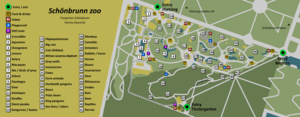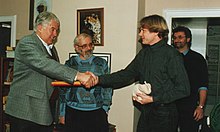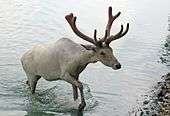Tiergarten Schönbrunn
Tiergarten Schönbrunn (literally, "Schönbrunn Animal Garden"), or "Vienna Zoo", is a zoo located on the grounds of the famous Schönbrunn Palace in Vienna, Austria. Founded as an imperial menagerie in 1752, it is the oldest continuously operating zoo in the world.
 Giant panda in Vienna's Tiergarten Schönbrunn | |
| Date opened | July 31, 1752 |
|---|---|
| Location | Schönbrunn Palace, Vienna, Austria |
| Coordinates | 48°10′56″N 16°18′09″E |
| Land area | 17 hectares (42 acres) |
| Memberships | EAZA,[1] VDZ, OZO |
| Website | Official website |
Today, Tiergarten Schönbrunn is considered and regards itself as a scientifically administered zoo which sees its main purpose as a centre for species conservation and general nature conservation as well as in the fulfillment of the education mandate given to it by the legislation. The still preserved buildings of the baroque era, which have been complemented in the last years by elements of modern zoo architecture, still convey a good impression of the 18th century menagerie-buildings after the Versailles model.
History

The zoo was constructed in 1752 next to Schloss Schönbrunn by Adrian van Stekhoven at the order of the then Holy Roman Emperor, Francis I, husband of Maria Theresia, to serve as an imperial menagerie and is the oldest continuously operating zoo in the world.[2] It was centered around a pavilion meant for imperial breakfasts. Therefore, thirteen animal enclosures in the form of cut cake pieces were established around this central pavilion.
The central pavilions and the menagerie building were built by Jean Nicolas Jadot de Ville-Issey. A small zoo had already existed on the premises since 1540, but the complex was opened to the public only in 1779. Initially, there were no entrance fees.
Holy Roman Emperor Joseph II organized expeditions to Africa and the Americas to procure specimens for the zoo. The arrival of the first giraffe in 1828 influenced Viennese fashion and city life. Clothes', accessories', and other items' designs were influenced, and Adolf Bäuerle performed his play titled Giraffes in Vienna (German: Giraffen in Wien).
At the onset of World War I, the zoo was home to 712 species and 3,500 specimens. Due to diminishing food supplies during the war, the number of specimens rapidly sank to 900. After the dissolution of the Austro-Hungarian Empire after the war, the zoo became the responsibility of the Austrian Republic.
Bombing raids on February 19 and February 21, 1945, during World War II, had an even greater impact on the zoo. Many buildings were destroyed and specimens killed, reducing the stock of specimens to 400. The new zoo director, Dr. Julius Brachetka, eventually managed to restore the zoo.

The zoo experienced a financial crisis in the 1980s, but closure of the zoo was prevented by privatization in 1992. Dr. Helmut Pechlaner was assigned as manager of the zoo. After his retirement on 1 January 2007, his deputy, Dr. Dagmar Schratter, took over his post.
Pechlaner was able to renovate and extend many of the enclosures thanks to a number of sponsors and significantly increased entrance fees. During his time as manager, the zoo was extended by a number of new buildings, including the rainforest house, the desert house, and the "Tyrolean farmhouse". A number of rare and exotic specimens, such as giant pandas and koalas, were attracted to the zoo and contributed to its upswing in popularity.
Description


Tiergarten Schönbrunn is one of the few zoos worldwide to house giant pandas. The zoo's pandas are named Yang Yang (F), Long Hui (M), Fu Long (M), and Fu Hu (M).[3] Fu Long's birth on 23 August 2007 was the first natural insemination panda birth in Europe.[4] Fu Hu was born exactly 3 years later, and he was also conceived by natural mating.[5] One more panda cub, Fu Bao (福豹), was born nearly three years later on 14 August 2013 via natural mating.[6] On August 7, 2016, Panda cub twins Fu Feng and Fu Ban were born.
Other zoo attractions include a rainforest house, in which the spectator is led through a simulation of the Amazon rainforest, an aquarium, which enables spectators to walk through underneath a simulation of the Amazon in flood, and, more recently, an exhibit of animals in unnatural habitats.[7] The new polarium for animals of the Arctic region was opened in early 2004.
On 14 July 1906, the zoo saw the birth of the first elephant in captivity.[8]
From its privatization in 1992, it has been led by Helmut Pechlaner, also president of WWF Austria, who managed to modernize most parts of the zoo and sustain its financial situation. In 1998, Pechlaner requested Swedish elephant consultant Dan Koehl to retrain the elephants and form a new elephant team, when the zoo was forced to change the team of elephant keepers, during a period when the zoo was faced with an aggressive campaign concerning its keeping of elephants.[9]
Pechlaner was followed by Dagmar Schratter. Nowadays, since 2019, the zoo is managed by Stephan Hering-Hagenbeck. who previously was director in Tierpark Hagenbeck.[10]
Private and corporate sponsorship for the various animals is one of the methods employed by the zoo today, along with bookable night excursions and special children's programs. Zoological research takes place at the zoo.
In the media
Apart from 1998 when the zoo was faced with an aggressive campaign concerning its keeping of elephants, a number of tragic accidents have plagued the zoo. In 2002, three jaguars attacked a caretaker during feeding, killing her in front of zoo visitors. The director tried to help and sustained heavy arm injuries. In February 2005, a young elephant, Abu, lethally crushed his caretaker. In the following press storm, director Pechlaner offered to resign over the issue.[11]
The zoo is a filming location for the ORF series, Tom Turbo, which is based on a series of children's books by Thomas Brezina. Tom Turbo has its garage at the zoo since 2006, and is, together with its creator, sponsor of a tiger at the zoo. Former zoo director Pechlaner makes cameo appearances in a number of episodes.[12]
The 250 Years Vienna Zoo Silver Coin
On its 250th anniversary, the zoo was the topic of one of the most famous silver collectors' coins: the 5 euro 250 Years of Vienna Zoo commemorative coin minted on 8 May 2002.
The reverse shows the Emperor's Pavilion surrounded by a variety of animals from the zoo. The dates 1752-2002 refer to the anniversary and also the year of the coin’s minting.
See also
- Tygerberg Zoo

References
- "EAZA Member Zoos & Aquariums". eaza.net. EAZA. Retrieved 2 February 2011.
- Glenday, Craig (2013). Guinness World Records 2014. pp. 38. ISBN 978-1-908843-15-9.
- "Panda Baby Diary: Viennese name their panda". Schoenbrunn Zoo. Archived from the original on 2007-11-19.
- "Rare panda birth at Austrian zoo". BBC News. August 23, 2007. Retrieved May 25, 2010.
- Veronika Oleksyn (Dec 13, 2010). "Austrian panda cub shies away from camera". Associated Press. Retrieved March 24, 2011.
- APA (Aug 15, 2013). "Pandababy im Wiener Tiergarten Schönbrunn geboren". der standard. Retrieved Aug 15, 2013.
- "Unnatural Habitats: Rethinking the Modern Zoo". Archived from the original on March 31, 2012. Retrieved September 14, 2012.
- Article at wien.info Archived 2013-02-18 at Archive.today
- "Elephant Consultance references". www.elephant.se.
- Hering-Hagenbeck neuer Tiergarten-Chef auf ORF vom 30. Oktober 2019, abgerufen am 30. Oktober 2019
- Pechlaner offers to step down
- "Helmut Pechlaner". tv.ORF.at (in German). Retrieved 25 December 2019.
Literature
- Ash, Mitchell and Dittrich, Lothar (ed.), Menagerie des Kaisers – Zoo der Wiener, Pichler Verlag, Vienna, 2002. ISBN 3-85431-269-5
- Helmut Pechlaner, Dagmar Schratter, Gerhard Heindl (eds.): Von Kaiser bis Känguru. Neues zur Geschichte des ältesten Zoos der Welt. Vienna 2005, ISBN 3-7003-1497-3
External links
| Wikimedia Commons has media related to Tiergarten Schönbrunn. |
- Official website (in English)
- Tiergarten Schoenbrunn on zooinstitutes.com
